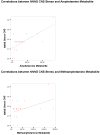Prenatal methamphetamine use and neonatal neurobehavioral outcome
- PMID: 18031987
- PMCID: PMC2358984
- DOI: 10.1016/j.ntt.2007.09.005
Prenatal methamphetamine use and neonatal neurobehavioral outcome
Abstract
Background: Methamphetamine (MA) use among pregnant women is an increasing problem in the United States. How prenatal MA exposure affects neonatal neurobehavior is unknown.
Objective: To examine the neurobehavioral effects of prenatal MA exposure.
Design: The Infant Development, Environment and Lifestyle (IDEAL) study screened 13,808 subjects and 1632 were eligible and consented. 166 (n=74 exposed) were enrolled in a longitudinal follow-up. Exposure was determined by meconium assay and self-report with alcohol, marijuana, and tobacco present in both groups. The NICU Network Neurobehavioral Scale (NNNS) was administered within the first 5 days of life. Analyses conducted on NNNS summary scores included exposure group effects, heavy MA use effects, association with frequency of use by trimester, and dose-response relationships with amphetamine metabolites.
Results: After adjusting for covariates, exposure to MA was associated with increased physiological stress. Heavy MA use was related to lower arousal, more lethargy, and increased physiological stress. First trimester MA use was related to elevated stress abstinence. Third trimester use was related to poorer quality of movement. Higher level of amphetamine metabolites in meconium was associated with increased CNS stress.
Conclusions: Prenatal MA exposure was associated with neurobehavioral patterns of decreased arousal, increased stress, and poor quality of movement. The dose-response relationships may represent neurotoxic effects from MA.
References
-
- Altshuler SJ. Drug-Endangered children need a collaborative community resonse. Child Welfare. 84(5 AD):171–190. - PubMed
-
- Arria AM, Derauf C, LaGasse LL, Grant P, Shah R, Smith L, Haning W, Huestis M, Strauss A, Grotta SD, Liu J, Lester B. Methamphetamine and Other Substance Use During Pregnancy: Preliminary Estimates From the Infant Development, Environment, and Lifestyle (IDEAL) Study. Matern Child Health J. 2006:1–10. - PubMed
-
- Billing L, Eriksson M, Jonsson B, Steneroth G, Zatterstrom R. The influence of environmental factors on behavioural problems in 8-year-old children exposed to amphetamine during fetal life. Child Abuse and Neglect. 1994;18:3–9. - PubMed
-
- Billing L, Eriksson M, Larsson G, Zetterstrom R. Amphetamine addiction and pregnancy. III. One year follow-up of the children. Psychosocial and pediatric aspects. Acta Paediatr Scand. 1980;69:675–680. - PubMed
Publication types
MeSH terms
Substances
Grants and funding
LinkOut - more resources
Full Text Sources
Medical


